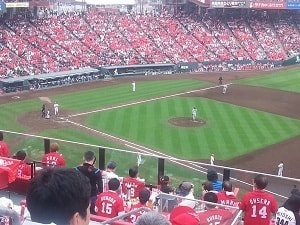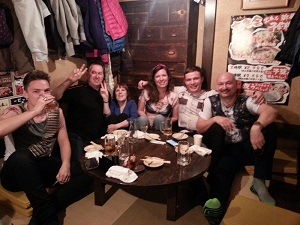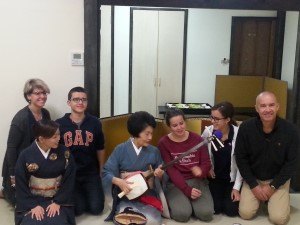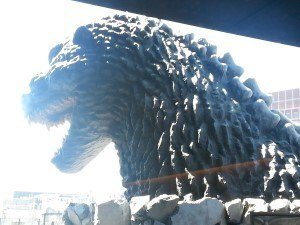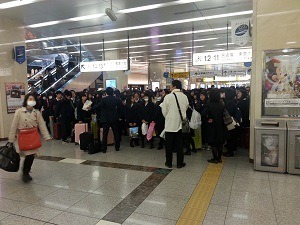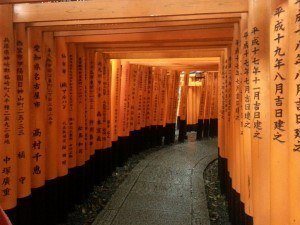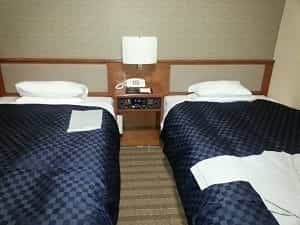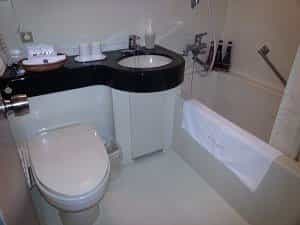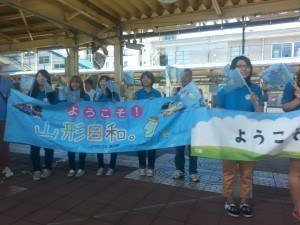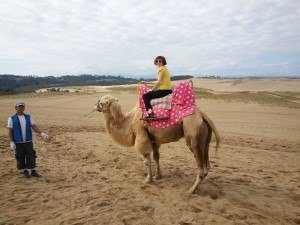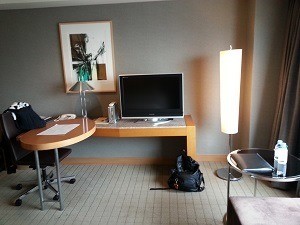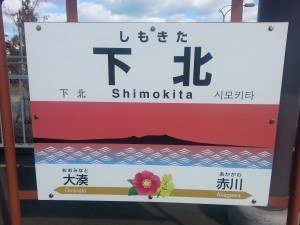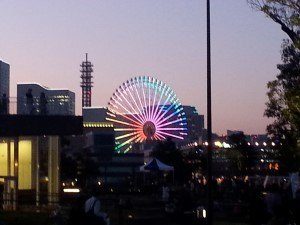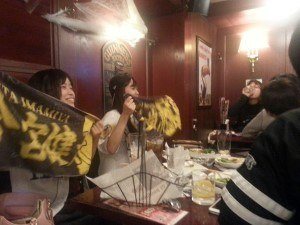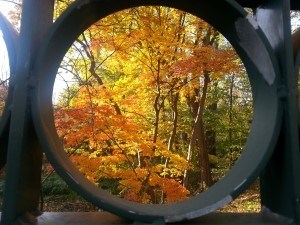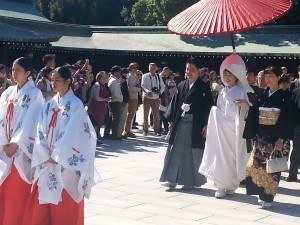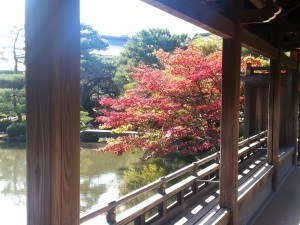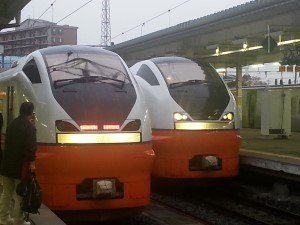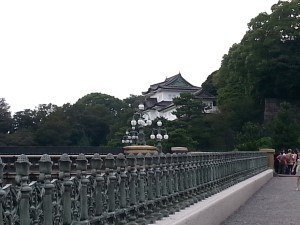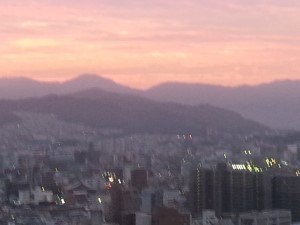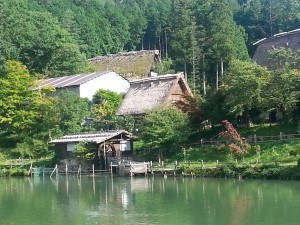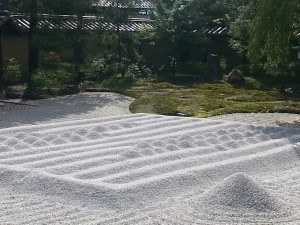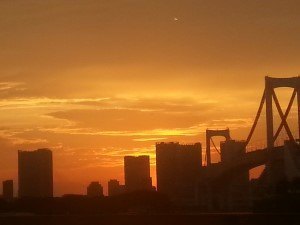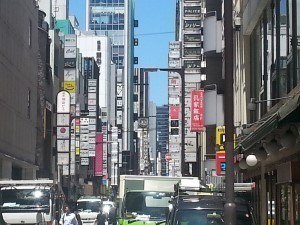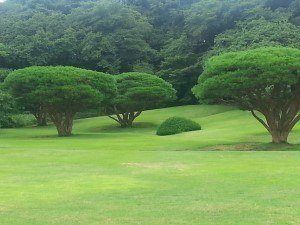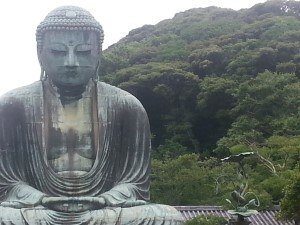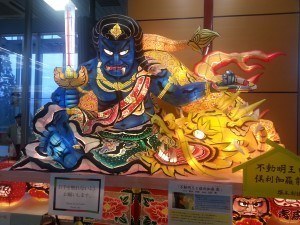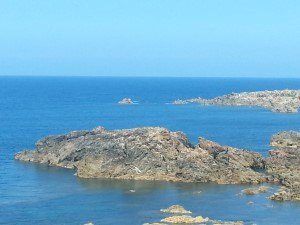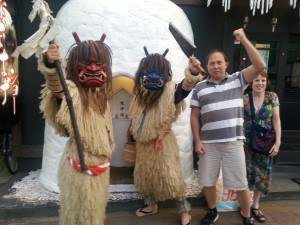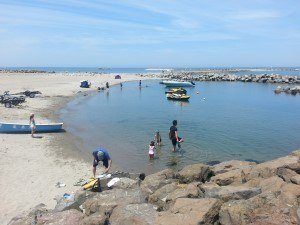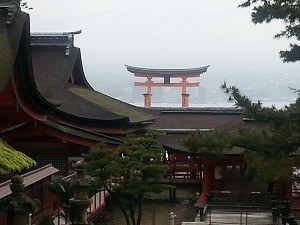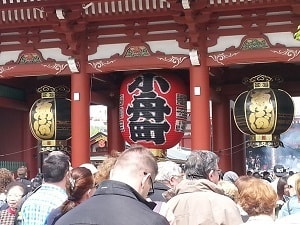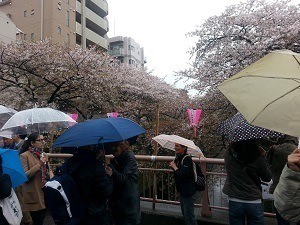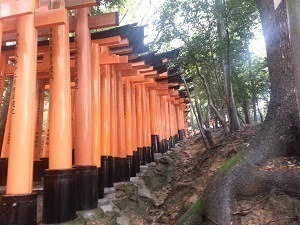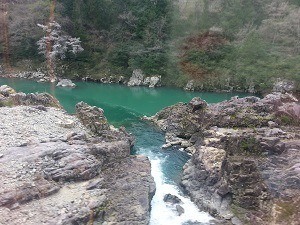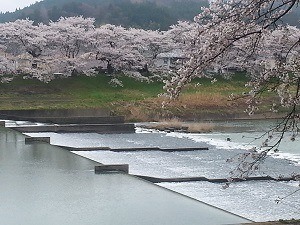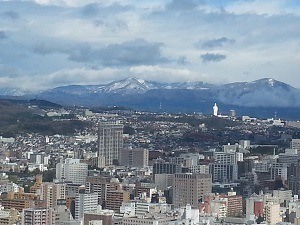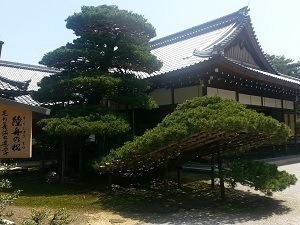Public transport in Japan - probably not what you think. |
|
|
Many inquiries we get include a request to avoid public transport and use a van, car or bus. In each of these cases we then have to explain why travelling by road is a bad idea and that "public" transport is probably not what they are used to in their home country, along with issues about the added expense, time and restrictions it places on potential tour schedules. Most people visiting Japan fly, but they do not consider that travelling by plane is public transport. Perhaps that is because airlines are privately owned. On that basis, just looking at Tokyo, the majority of the fourteen railway companies are not public transport either as they are privately owned too. The Metropolitan Government does own one of the two subway companies, but that means the other thirteen companies are private. So, given that most train companies are private and not public, the distinction becomes one of crowded mass-transit versus less crowded options. Certainly in the case of a morning rush-hour commute in Tokyo many trains are jammed full of people, but even those commuter lines can be relatively empty and comfortable during the day. They still provide reliable, efficient, cheap and frequent point-to-point transport. As a contrast, getting around Tokyo by car can take a long time due to congestion, and then finding somewhere to park can be a big problem. (The fact the Imperial Palace has bus parking makes it a frequently visited tourist site, but certainly not a must-see location in the capital.) Even for some of the longer city routes, express trains provide comfortable and reserved seating. This allows us to take a train for one to two hours and visit locations in half the time of the road alternative. Places like Kamakura, Hakone and Nikko become viable day trips. Going long distance, the shinkansen shrinks the country significantly. With a boarding process that takes less than five minutes, and speeds over 300 km/h, passengers are provided comfortable and spacious transport. A trip from Tokyo to Kyoto can be completed in two and a half hours. Flying would be a comparatively tedious four or more hours (with an hour in the air, check-in, security screening, luggage claim and getting to/from an airport), and travel by road takes most of a day. There are places where we do use road transport including buses (to visit the snow monkeys or Lake Chuzenji at Nikko) and taxis (especially getting around Kyoto where the train network is not as extensive and the buses are something to be avoided). These are generally cases where the train network does not best meet our needs, or in places where travelling by road provides a quick point-to-point option. But, then we do not have to worry about parking or limits on drivers' hours that might otherwise get in the way of our sightseeing. |
|
|
For November 2016 we organised two tours to enjoy the fall colours. While 2015 was muted, the 2016 season turned on some great displays around the country. Over the course of five weeks we visited many of the usual places like Tokyo, Kyoto, Nara and Hiroshima, with visits to Nagano, Kanazawa and Takayama also supplying good locations. Early Autumn Tour: Our early tour guests were all from Australia. That is not especially unusual as more than half of our guests come from Australia, and it gave them an opportunity to tell some good jokes about Kiwis and ask us to speak "English". With settled weather, the trip to Hakone gave some great views of Fuji from Lake Ashi and our trip to Nikko to enjoy the autumn colours maybe missed the peak by two days, but between the township of Nikko itself and Lake Chuzenji and Kegon Falls there were some lovely displays. Heading away from Tokyo and into the Alps we were treated to an impromptu lion dance at our ryokan (in addition to the geisha performance we arrange). After Kanazawa we reached Kyoto and Arashiyama for one of the more famous local leaf viewing spots. Our side trip to Nara coincided with a lantern festival, and making the most of Hiroshima saw us get back to Kyoto fairly late in the evening. A detour via Takayama on the way back to Tokyo also delivered some nice scenery. Late Autumn Tour: Our second tour group was nice and compact. While the criss-crossing the country took a different route, we covered many of the locations as the earlier tour, but with the addition of Osaka to break up one of the longer travelling days. One of the features of our tours is that they are all different and sometimes develop their own themes. This time it revolved around a daily "I did not know that" start to the day where everyone came up with some unusual or interesting "fact". (Unfortunately Google often revealed a different story.) For this tour some of our best leaf viewing was at Matsushima Bay. Doable as a day-trip, the shinkansen to Sendai and local train out to the bay (one of the "three views of Japan"). Hiroshima/Miyajima and Kyoto also turned on good displays, especially at the beautiful Kiyomizu-dera temple.
Fortunes tied outside Nagano Temple, Flower festival at Odawara Castle
|
|
International Relations: Touring with an Overseas Operator |
|
|
August 2016: We recently contributed this article to TourMatters.com and reproduce it here.
Your usual tour organiser or agent might be someone who shares your background or expectations. But when you start working with a provider based overseas, or with a company that serves travellers from around the world, cultural differences become more apparent. These variations show up in the group dynamics, sightseeing expectations, and even transportation choices.
Compare and Contrast Our insight comes from our specialty, taking English-speaking tourists to Japan. In our experience, key points between US and local operators are the same.
The main difference for US travellers is touring with a company that delivers services to people from multiple countries.
Choosing to work with an operator based overseas, like Japan Custom Tours, is a case of self-selection. You're opening yourself to the opportunities that a more diverse group provides. That includes anticipating that not everyone will speak English, and that things will be quite different than they are at home.
To Know Before You Go What are the pros and cons to planning your vacation with a company that might literally be on the other side of the world?
What the Experts Say Most of our guests are from the US, UK, Australia, Canada, and New Zealand, and the main themes we've observed are:
Most of our guests are well-travelled and their feedback is about the memorable experiences they had. Ultimately, travellers generally have a better trip because of the varied perspectives of a multi-national group and a broader approach to Japan. |
Baseball - a popular import.
Hiroshima A-Dome - mixed American and Japanese history.
Hotel rooms are not always "western" style.
Guests enjoying a busy izakaya dinner.
Experiencing a different culture close up.
Just visiting Tokyo. |
Tourism in Japan - Growing the Numbers |
|
|
April 2016: As part of the build up to the 2020 Olympics in Tokyo the Government of Japan set an ambitious target of growing tourist numbers to 20 million per year. With improving global economies the travelling public has flocked to Japan and the target was reached in 2015. So the Government decided to double the target to 40 million. Of course the setting of targets by a central agency and actually delivering on the ground are two different things. Some Japanese people like the money that tourists bring, but do not like the crowds, or even the mix as the largest increases come from China, Korea and Taiwan. Even the Japan Times noted that there were insufficient hotels in some places (Tokyo and Kyoto) already so adding another 20 million tourists to full hotels will not work. Having watched the growth over the last decade we have observed other places where the influx of visitors will strain the existing infrastructure. The following are a few that we encounter frequently and knowing how to avoid the worst of them can make the difference between a great trip, or one where you might have wanted avoid the experience. Trains: One of the best things in Japan is the extensive, reliable and efficient train system. From the Shinkansen to the local services, private lines and subways you can travel almost all of the places you want. For visiting tourists there are a few bottlenecks. Many visitors will have the Japan Rail Pass, a great value pass for long distance travel and be keen to exchange the voucher for the pass at the airport or one of the major train stations as soon as they arrive. Morning queues can be more than an hour as the processing is time consuming. Some travel service centres have limited space and counters, further slowing down the process and even the new office at Shinjuku station in Tokyo seems inadequate for the volume of visitors. Plan ahead or visit in the afternoon can be good options. The knock on effect of the rail pass is you need to buy tickets. Some ticket offices are limiting the number of days travel (to one) and purchasing from the speedy ticket machines is not an option. This can add 30-60 minutes if you are at a small ticket office with a big queue so do not count on being able to quickly get a ticket. Sometime knowing there is another office can make things faster. Getting tickets for you train can also be a problem. The rail pass limits the type of trains on the busiest Tokaido section between Tokyo and Osaka so the Hikari trains tend to have more tourists (and their luggage). This can sometimes make seating tight and you might have to get the next train. Other sections of the network have fewer trains and fewer seats, especially on the Osaka to Hiroshima section, so getting the times you want can be hard - booking ahead helps. Finally, with a rail pass you enter and exit the stations using a manned ticket gate. These are essentially designed to allow people and their luggage one way only. With two-way traffic it can grind to a halt, and with staff dealing with outer ticket issues a simple transfer to your train might suddenly have a five minute delay. Few stations have dedicated entry/exit gates and many stations do not have the space to add separate gates anyway. Hotels: For the most popular cities there are simply not enough hotel and ryokan beds available for the number of people visiting. This has two main consequences; one is that accommodation is likely to be the biggest expense for a trip to Japan and the other is that getting somewhere to stay might not even be possible. As a general rule, booking in advance gives the best prices and also greatest choice. Some international hotels offer booking up to a year in advance, many others six months and some just three months. Last minute (a month before) can see prices 50% higher or more, especially during peak seasons. The other consideration for the growth in tourism is that hotel pricing will drive people into the regional areas where prices are lower. A luxury five star hotel in a second tier city might be cheaper than a 3 star business hotel in Kyoto or Tokyo. Some of our favourite places to stay provide exceptional service, space and comfort. On the issue of space, many visitors are surprised at the size of hotel rooms. Cheap or cheaper hotels can be very compact with rooms starting at 10m2 (about 110 square feet). Into this space they can fit a bathroom, bed (often single for two people) and a desk. People need to know what they are booking and we have witnessed people exclaiming rooms are impossible for two people. Going up the scale, we find rooms around 18m2 to 22m2 provide enough space, but the bed might still be pressed against a wall and floor space may not be sufficient for two suitcases! This can be a problem for tourists used to more spacious rooms, and a last-minute change of room can cost more than a 5 star hotel. One option is to book twin rooms as they tend to be slightly larger. For Japan, needing to build more hotel rooms is not a case of simply adding more shoe-boxes, but good quality rooms with international travellers in mind. People travelling with large suitcases, not the small ones favoured by domestic travellers. Tourist attractions: Make no mistake, the popular tourist attractions are crowded. This can turn a beautiful spot into a heaving and confused group of people not really sure where to go or what to do. Special moments might feel more manufactured after standing in line for 30 minutes to see or do something everyone else wants to do, or what should be a tranquil spot ruined by 100 people with selfie sticks. Even an attraction like the Fushimi Inari Shrine (10,000 torii gates) now has instructions on which route to walk rather than being free to wander the route according to whim. A similar approach in Gion where traffic police/security directed pedestrians is an indication of things to come, less spontaneous and more control of public spaces. Many of the most popular places can actually be avoided without any loss of enjoyment. Rather than seeing the #1 spot, settling for #2 can actually be better. The key for Japanese tourism is communicating the differences between the options. Our travels mean we can select alternatives for our guests based on what they like and still deliver something spectacular. Possibly the issue for Japan is that it has so many great attractions, world heritage sites and people following their guidebooks that is not possible to get people to change their priorities. After all, if someone really wants to visit Himeji Castle with a 2-hour wait to get in, getting them to visit Hikone castle with no other tourists can be a hard sell. Off the beaten path: For Japan to fully capitalise on its tourism potential it needs to promote and encourage visitors to head to the less well known regions. The main entry points will probably remain as Tokyo and Osaka, and huge numbers will want to cover the main attractions on the Golden Route between these two cities including Kyoto. The charms of the country can be lost in the way Japan is promoted. Much is focused on the Tokyo metropolis, historic Kyoto, shopping and nightlife. Short package tours will bus people to popular attractions for the photo opportunity and rush around the sights, all on a budget. This makes Japan easy and accessible for many, especially those that are not confident exploring a country in a foreign language. Our experiences and the feedback from our guests is that the less common places we visit are more scenic, authentic and interesting. Getting away from the crowds and into some of the more remote or smaller towns and cities affords a different set of experiences, often more relaxed and providing excellent value for money. The presence of English dries up pretty quickly, but with help or knowing a little of the language there is a lot of Japan that would welcome people to their area or region. The Japanese are, after all, very proud of their country and like to show it off for visitors. |
A group waiting for their shinkansen.
It is possible to get photos with no one in them, even at famous spots.
Twin beds for extra room space.
Compact bathroom - everything you need.
Locals at a small station welcome tourists.
Expect bigger crowds in the future at popular spots.
Off the beaten path.
People in photos - the professional ones clear out the tourists.
Space can be worth paying for. |
Autumn Leaf Viewing Season 2015 |
|
|
October/November 2015 We ran a couple of tours for Autumn, one with some guests from the USA and the main Autumn tour designed around a specific set of requests covering a lot of different locations. As there was a gap between the two we took the opportunity to head to Hokkaido for a week. Over the course of six weeks travelling around Japan we covered a lot of ground. Some of the usual places like Tokyo and Kyoto, and some new places as well. October in Yokohama: Before our guests arrived we stayed briefly in Yokohama, a short commute south of Tokyo to see what the city was like. Staying between the baseball stadium and China Town proved to be good location. Not too far from the local train station for when we needed to head back up to Tokyo, and also close to some of the other attractions in the area. These included the port area where the local Octoberfest was being held. The warn autumn weather allowed people to enjoy the sun during the day and some beer during the warm evenings as well. Early Autumn: Our first tour guests flew in from New York and to make the most of their limited time (they only had a week) we headed straight to Kyoto. We were able to show off some of the early autumn leaf colours at Heian Shrine, covered both the Silver Pavilion and Golden Pavilion and Nijo Castle. Heading back to Tokyo we stayed in the Ryogoku area as they wanted to meet with a local friend. Being able to stay in a less "popular" area had several distinct advantages. Namely, we had a great location, good hotel (good value for money), and were able to appreciate the local attractions (including shrine and museums) which normally get overlooked. Sapporo: With our New Yorker's heading onto Shanghai, we headed north to Sapporo. The march 2016 extension to Shin-Hakodate will take some of the time off the train trip, but it was still interesting taking the slower trains through the Seikan Tunnel between Honshu and Hokkaido. Sapporo at the end of October and beginning of November had good displays of colour on the trees around the city. The city parks were varied and the extensive underground shopping and pedestrian spaces were interesting to explore, and probably very useful in the middle of winter. Some of the places we visited in the city were very good, others were pretty average. Possibly because many people that visit are focused on other areas during the warmer months, and the Snow Festival and skiing in February. We took a couple of day trips while in town. One to Otaru and its "canal district" was a disappointment and seemed designed as a tourist trap. The other more interesting excursion was to Lake Toya and the Usuzan ropeway. The walk around the volcanic crater in the light snow was very good - although a high degree of fitness would be required (lots of steps). Also, access by public transport is limited, but doable, so pleased to have gone and had a look. After Sapporo we stopped into Aomori for a couple of nights. This allowed me to take a trip out to Shimokita which is essentially the end of the rail line (which is the next stop Ominato), and where the bus service runs to Ore-san, one of the more sacred places in Japan - and one of the more difficult ones to get to as the buses do not run in winter. Autumn in November: Returning to Tokyo we collected our next group for a 16 day tour around the middle of Japan. The schedule had already knocked a few places off the "wish list" but still saw a lot of places in a fairly short period of time. These included Nikko (where the autumn leaves were probably at their best), Sendai (and the ferry ride around Matsushima Bay), Nagano (with a day trip to Matsumoto Castle), Kanazawa (where the castle was a useful respite from the rain), Hiroshima, and Takayama (including some relaxing onsen time). For Kyoto, we stayed at a ryokan in the Arashiyama area, and while the location was good, close to the river, bamboo grove and temples, the autumn season for 2015 was certainly not one of the best. Some trees were still green, others without leaves and few displaying the rich yellows, oranges and reds we had hoped for. But, the weather and nature decides what each season is going to be like, so we simply enjoyed what was on offer. This particular tour moved at a fairly fast pace and like a lot of activities in Japan, requires a fair amount of walking to be able to see the different sights - either because they are spread-out or at the top of hills/steps. Often there is not a public transport option and while we made extra use of taxis this time around, we needed to effectively run things in a two-speeds; one for the guests that were more fit, and another with limited walking each day. Normally groups are reasonably well matched, and is why we ask people about their fitness.
Shimokiti Station Yokohama waterfront
|
During the baseball finals - Tokyo
Autumn colour in Sapporo
Wedding at Meiji shrine
Miyajima in early evening light
Heian Shrine Gardens Kyoto
Autumn leaves - some brilliant reds
Trains serving Aomori to Hakodate |
Tour recap - September 2015 |
|
|
September 2015 Our September tour. The following is a brief recap of the tour and places we visited with our guests. Sept 3rd: A pretty straight forward day picking up our guests (a family of four adults) at Narita late in the afternoon before travelling into Tokyo to Shibuya Station. As they were adjusting to the time-zone change, we agreed simply to approach Tokyo starting the next morning. Sept 4th: Summer was behaving, turning on clear skies and hot temperatures. The subway efficiently took us to Asukusa and Sensoji, allowing browsing the stalls and some shaved ice to keep cool. next we travelled across to Harajuku to browse the main shopping street and heading across to the Omotesando shopping street for lunch and to check out the Prada flagship store. Interrupted by a thunderstorm we were a little late to get across to the Shinjuku gardens, but covered some of the locations in Shibuya instead (Hachiko statue and scramble crossing). Sept 5th: Taking the Hokuriku shinkansen across to Kanazawa giving enough time to explore the castle and also the Kenrokuen Gardens. After the 21st Century Museum of Contemporary Art we enjoyed dinner and a walk around the Higashi Chaya district of old style buildings. Sept 6th: The morning started with a look around the Omicho market and a breakfast of fresh sashimi. Taking the train across to Kyoto we used the afternoon to visit to the Fushimi Inari shrine and a trek up the mountain (admittedly, some people trekked further than others). Sept 7th: Today (rainy) provided the opportunity to see both Ginkakuji (the "silver pavilion'') and Kinkakuji (the "golden pavilion") on the same day and contrast the two. One was filled with bus tours, crowded and good to see once. The other more varied, uncrowded and peaceful. We also walked along the Philosopher's Walk and across to Heian Shrine. The shrine gardens were a relaxing and beautiful addition to our visit. Sept 8th: This was our day trip to Nara. The deer seemed less pesky, and Todai-ji continued to impress (Ms K did not crawl through the pillar in the temple, but had a pretty close look). Walking to Todaiji Nigatsudo, Tamukeyama, Mizutani and Kasuga Shrine rounded out the visit. Sept 9th: The start of the day included a walk through the 400 year old covered Nishiki Market before walking across to Gion and the old streets. Using the back streets of Ishibe Alley we included Entokuinteien, Kodai-ji temple, Maruyama park and Yakasa shrine. The gravel gardens had been re-shaped since our previous visit and there were the early hints of autumn colour in a few of the maple trees. Sept 10th: A fairly relaxing day heading Hiroshima and visiting the historic A-dome (atomic bomb dome), Peace Park and the museum. Groups of school children were delivering paper cranes and others were interviewing visitors, bravely testing their English skills. Sept 11th: One of the nicest days we have had in Japan - the weather was stunning - warm, no cloud, light breeze - a great day to head to Miyajima Island and Itsukushima Shrine. On arrival we were able to enjoy the floating gate, and by the time we were ready to leave the tide had receded so we could walk out and check the coins embedded in the cracks and between the barnacles on the massive torii (for people making a wish). Sept 12th: Leaving the coast behind, we headed to Takayama and a stay at a traditional Japanese ryokan (inn). Certainly the change of accommodation style had our guests a little perplexed initially, but they soon found the futons were quite comfortable (maybe they will onsen on their next trip). The afternoon allowed for some exploring of the old part of the town and sampling a few of the local food treats. Sept 13th: The morning markets along the river provided lots to look at before we headed to the festival floats exhibition hall. Next to the hall is a little puppet museum where the different styles are displayed and operated in a short and interesting show. The afternoon included a trip to the Hida Folk Village, a collection of old buildings that have been shifted to Takayama from around the region. Exploring the inside of some of the larger buildings showed off the impressive construction. Sept 14th: As we had secured some last minute sumo tickets, we transferred back to Tokyo and across to Ryogoku. Even with seats towards the back, we had an excellent view of the dojo (ring) and enjoyed seeing the top ranked wrestlers perform. Sept 15th: Last day for our guests. As we were staying across from the Government Metropolitan Building we included a trip to the observation floor (200m up) for a view of the city before walking across to the east side of Shinjuku. One of the last things they wanted to do was to see the Imperial Palace, so a short trip on the train took us across the city to the Palace. After two weeks, the trip back to Narita airport took everyone back to where they started for their flight home.
Prada Building Omotesando Kanazawa castle
|
Tokyo Skyline
Imperial Palace
Hiroshima sunrise
Hida Folk Village
Takayama Float Exhibition Hall
Heian Shrine Gardens Kyoto
Kodaiji gravel garden |
Tour recap - July Summer 2015 |
|
|
July 2015 Our summer tour was split into two parts; a Tokyo based week followed by a two week circuit taking in a large portion of Honshu. The following is a brief recap of the tour and places we visited with our guests. July 1: The first week of July saw us based in Shinjuku (Tokyo) exploring different areas of the city each day. As we were based about 20 minutes from the main Shinjuku station, it was also an opportunity to make use of some of the other train stations in the area (there are five subway stations aside from the main JR station). July 2: We had a short trip to make to Naka-Meugero, fairly close to the park where we had our hanami party in April. The rainy season made the trip a bit damp, but this quiet area of Tokyo highlights the different areas hidden in the city. July 3: More rain, so we headed off to Odaiba and took the Yurikamome Line (automated, guided rail) from Shiodome to the Aomi station. The massive Toyota showroom had a lot of additional displays and the adjoining Venus Fort shopping mall was created in the style of a European village (complete with sky). A bonus was the "history garage" a free car museum that formed part of the overall complex. The evening got taken over by a visit to a beer garden with friends in Shinjuku. July 4: A day trip to Kamakura. This included the Hase Dera shrine, transcribing a Buddhist scripture, Kotoku-in with the large bronze Buddha (Y10 to go inside), lunch of the local specialty shirasu (a tiny fish served raw or boiled), a visit to Engaku-ji shrine and some zen meditation, and finally a trip to the "money washing" shrine Zeniarai Benten. July 5: The plan for Sunday was to head to Meiji Jingu and Yoyogi Park to see either cos-play or rock-a-billy performers. Perhaps it was the cloudy weather or simply the wrong area of the park, but no-one in sight so we headed across the main road to an outdoor festival - good quality stall food and live music. Continuing on took us to central Shibuya and provided a good indication of the distance to Shinjuku that you miss travelling on the trains. July 6: The original plan was to head to FujiQ, but we were advised (by the bus operators) that the rain would make it pretty dull without the rides in operation. So, off to Omiya and the JR East museum. A slightly different style to the rail museum in Nagoya, but the main points of interest were the train simulators - Y500 for about 15 minutes driving a steam train was well worth it. July 7: We had a request to visit Yanaka Ginza, a small, old style shopping street so headed off to Nippori station and the short walk to the shopping area. The area is nice with a few shrines, but the destination itself is quite small extracting a "is that it?" response. After lunch we took the Hyabusa Shinkansen to Aomori - the high speed of this section covers the more than 700 km distance in a bit over three hours. July 8: The train schedules made a visit to Mt Osore impractical, so we headed to Hirosakai where the Castle and park are a major feature of this town. The castle was interesting for its modest size (compared to the other more famous castles) and also because it is in the process of being moved 70 metres while renovation work is being done. The castle gardens are extensive, including a botanical garden, 2600 cherry trees (not in bloom), and a triple moat complex. We expect it would be stunning in April. July 9: The main obective for this day was the journey along the Gono line from Aomori to Akita via the coastal route. There is a sightseeing train that covers the journey in a little over five hours, including a couple of stops where you can take photos of the rocky coast line. The live, traditional music performance on the train was a little unexpected. The Senshu gardens (and ruins of Kuboto Castle) provided a quick excursion during the afternoon. While the area reminded us of some of the more popular spots in Kyoto, there were almost no people around making it pleasant to stroll around at leisure. A highlight in the evening was a visit to a ice cave themed restaurant where Namahage monsters burst into the individual dining rooms and scare people - good food and hugely entertaining. July 10: A short shinkansen ride to the small town of Kakunodate (a town of c18,000 people). The attraction here is a set of old style samurai houses that are well preserved (and some being lived in). There were a few Japanese tourists visiting, but very uncrowded. July 11: Another train day heading further south along the west coast going from Akita to Niigata, enjoying the mix of coastal scenery and the nearby mountains. The afternoon provided an opportunity to visit the anime/manga museum and then check out the river that runs through this city. July 12: A mixed day as everyone did something different. These included a visit to the beach, aquarium and the port area via the loop bus. July 13: Time to head to Kanazawa with a transfer from the local trains to the Shinkansen. We were a little spoiled here as we had chosen combination western/Japanese style rooms which were spacious and luxurious - very comfortable. July 14: Starting the day with fresh sashimi from the Omicho market (across the street), there was plenty of time to explore the castle, Kenrokuen gardens and the temple district. July 15: Heading away from Kanazawa to Kyoto where we have three nights of ryokan accommodation. For the evening, a Japanese BBQ provided a hearty meal of beef, pork and chicken with a few side dishes along the way. July 16: After starting at Nishki market we headed to Ginkaku-ji (the Silver Pavilion). After golden pavilion it was interesting to see how much more extensive the grounds are, and the lack of people. While the pavilion is not actually silver, it has more to see than its counterpart. Heading away from Ginkaku-ji we walked along the Philosopher's Walk towards Heian Shrine. Outside of blossom season (and on a cloudy day) it was not particular special, but we stopped in at the Okazaki shrine along the way. The overall Heian Shrine area appears huge, but many of the buildings are not accessible, but they were visible from the road. However, the main buildings are impressive and well worth the time taken to visit. July 17: This was our sumo day. A short trip across to Nagoya and to the Aichi Prefectural Gymnasuim. Good box seats, some delicious bento for lunch and some great wrestling. The trip back to Kyoto was slightly delayed (20 minutes) because of the typhoon activity further south. July 18: We had a day scheduled for Nagoya for a number of different sights including the castle and park. As a largely unstructured day, people went in different directions including to the Toyota Textiles and Automotive Museum. July 19: Back to Tokyo for the last few days of the tour. For two of our guests this included a trip to Yokohama and to the Nismo Omori Factory (and to browse car parts). July 20: The Monday was a public holiday and some of our Tokyo friends had suggested a dinner cruise. With summer kimono available the ladies dressed in yukata before we enjoyed good Japanese fare on the way down the Sumida River to Odaiba. Conditions were pretty much perfect with arm temperatures, sun and no wind - made Tokyo look stunning. July 21: For our final morning a short trip from Ginza to Hama Rikyu gardens. It was interesting to see the contrast of this famous site compared to some of the other parks in Tokyo. The sea water moat was an unusual feature, but the imposing skyscraper skyline was a constant reminder that you were in a big city.
Tokyo at sunset looking across at the Rainbow Bridge Ginza under the summer sun
|
Shinjuku gardens
Kamakura Buddha
Heian shrine
Aomori lanterns
Train journey along the western coast of Japan
Namahage at the restaurant, Akita
Ginkaku-ji
Niigata beach |
Tour recap - April Cherry 2015 |
|
|
April 2015 Our April cherry blossom tour covered a lot of ground across 21 days and chasing cherry blossom to different parts of Japan. The following is a brief recap of the tour and places we visited with our guests. April 1: Our first guests J&L arrive from Australia, but after suffering a three hour delay in Singapore. Very tired, but on the plus side this allowed us to transfer to the Monterey Akasaka and check them into the hotel without a delay. After they had a well deserved sleep we headed to the restaurant area in Akasaka during the evening to one of the friendly places we know. April 2: A beautiful spring day and travelling by the new Hokuriku Shinkansen delivered us efficiently to Kanazawa. The afternoon allowed for a leisurely exploration of the Kenrokuen gardens, cherry blossom and then to the adjacent Kanazawa castle. The "french" bistro food was excellent, followed by a walk around the old samurai area of town. April 3: After visiting the local markets and indulging in fresh sashimi for brunch we headed toward the mountains for a stay at Kamesei ryokan at Togura (near Nagano). A soak in the onsen followed by evening banquet featuring local foods rounded out the day. April 4: We had a special request to visit the snow monkeys and despite a forecast for light rain, the day turned out sunny and mild. There was still a little snow around the Jijokudani park and forest area and that added to the experience without being cold underfoot. The afternoon saw us heading back to Tokyo to pick up three additional guests (P,T&D). April 5: Our Tokyo friends had invited us to attend a Hanami party - cherry blossom viewing in a local park. The spring weather didn't help with wet and cold conditions. But we went anyway and lunch turned into a few drinks at our friend's apartment, and then to dinner. Made for a full day, but a rare experience for our guests. April 6: On the move to Kyoto and the Kyoto Century Hotel - very nice with rooms overlooking the trains arriving and departing from Kyoto Station. Time for a quick trip to Inari shrine before Japanese BBQ and a trip to our local karaoke bar - despite initial reluctance, P,T&D joined in with some interesting musical renditions. April 7: Our day trip to Nara and Todai-ji Temple. Even after many visits, it is still a "wow" place. Getting back to Kyoto there was a quick trip to the top of the station building for views over the city from the 11th floor observation deck. April 8: A morning visit to the Nishiki markets and some shopping time. We visited Kodai-ji temple in the early evening to avoid the worst of the crowds. Strolling across to Maruyama park to see the cherry blossom and enjoy some hot sake before dinner in the Gion district and looking at the old style streets and buildings afterwards. April 9: Changing pace, we headed to Takayama in the mountains of Gifu prefecture. The train winds along the Kiso River and with the change in elevation there were many cherry blossom to watch as we passed. At Takayama we stayed at a pleasant ryokan before enjoying a meal of high quality Hida beef for dinner. April 10: A fairly relaxing day starting with a visit to the local street market before looking around the old part of this small mountain town. Guests visited some of the local museums and enjoyed the foot spa near the railway station before a longer soak in the ryokan onsen. April 11: From Takayama we headed back to Tokyo to join up with guests from New Zealand (C&J) and from England (R,P&G). Patrick visited Narita again to collect guests flying in from Australia (D&U), while Wendy took the other nine to a local restaurant. April 12: With a nice day in Tokyo (a sunny Sunday) we went across the city to Skytree and then to a very crowded Asakusa. While R,P&G went off shopping in Harajuku, we hunted up some cherry blossom at Ueno Park. The main cherry season arrived early, but Ueno also has many late blooming cherry trees. Travel around the city was interrupted due to an accident on the main Yamanote (circle) line, so we used the subway to get to the bustling Shibuya district and the "scramble" crossing. P,T&D departed the tour, doing a few fun things in Tokyo before heading south to Hiroshima a few days, and J&L investigated the National Museum of Modern Art. April 13: Again chasing the cherry blossom (it is a cherry blossom tour) we headed north to Sendai. A short trip out of the city is Ogawara where 1,000 trees were planted along the river, and were in full bloom. Some very happy tour guests despite the damp conditions. Back in Sendai for the evening, the group enjoyed a wide range of delicious Japanese foods at a nearby restaurant. We were not too raucous, but it probably helped we had the use of a private room. April 14: Another short local train trip to Matsushima. Famous for the pine tree covered islands, we took the one hour ferry excursion around the bay getting some nice photos and watching the seagulls being fed from the back of the boat (until the guy got told off for attracting the birds). Lunch was a surprising good meal of tempura fish from a small shop, but we did not have the jellyfish ice cream desert. April 15: Time to head south and farewell J&L at Tokyo as they headed back to Australia. Continuing on to Kyoto, Patrick took D&U to Inari during a downpour! With wet shoes, the place was quieter than usual allowing some great photos of the torii gates. April 16: The second group day trip to Nara. Still lots of pesky deer and also a lot of school groups visiting the park and temple. April 17: While Wendy took C&J to Nishiki markets and sushi train for lunch, Patrick took R,P&G and D&U to Hiroshima for the day. Arriving at 9 a.m. gave more than enough time to visit Miyajima and it's floating torii gate, and also the A-dome, peace park and museum. Returning to Kyoto was delayed due to busy trains, but a local restaurant provided a good place for an inexpensive early diner. April 18: The morning saw us take the bus across Kyoto to Kinkakuji (the Goldern Pavilion). As it is a major tourist attraction, the bus was stuffed full and the grounds of the temple were also very crowded - not exactly a relaxing or serene atmosphere - but the day was sunny and Kinkakuji did not disappoint. In the evening we revisited Kodai-ji and its zen gardens, the bamboo grove and walk across to Gion for dinner. April 19: R,P&G had organised to head to Takayama while D&U needed to head to Tokyo for their flight home. So, we headed to Hiroshima with C&J. Arriving too early for check-in, we had planned to attend the local baseball game (Carps v Dragons). Hugely entertaining crowd and quite good baseball. The yaki tori were delicious washed down with a choice of sake or beer (Asahi or Kirin being the two main brands on sale). Carps won 5-0. April 20: The plan for the day was slightly interrupted due to a train "issue" so we went to the peace park first, including to the hypocentre marking the location of the actual A-bomb detonation. Visiting Miyajima in the afternoon allowed C&J the time they wanted to explore and take photos before heading back to Hiroshima. April 21: And, after three weeks, Patrick and Wendy get the morning train from Hiroshima back to Tokyo/Narita for their evening flight back to New Zealand. Time to organise the next tours.
Miyajima and the floating torii Passing Fuji-san on the way to Tokyo
|
Asakusa crowds
Tokyo hanami party
Inari shrine - 10,000 torii gates
Nara in spring time
Train journey into the mountains to Takayama
Ogawara cherry trees
Sendai from the Westin
Kinkakuji gardens (golden pavilion) |
![[Company Logo Image]](https://d3bb6cic8t0vq8.cloudfront.net/images/logo.gif)
 Scenic train on the Gono line
Scenic train on the Gono line 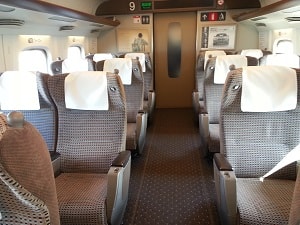 Spacious shinkansen seating
Spacious shinkansen seating  Yamanote line in Tokyo
Yamanote line in Tokyo 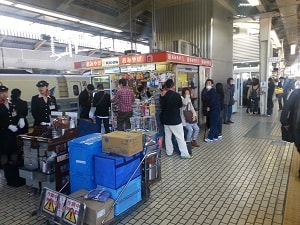 On the platform waiting for the next train
On the platform waiting for the next train 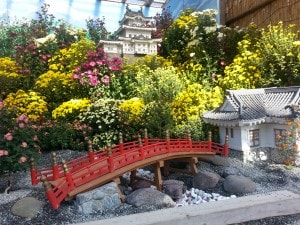

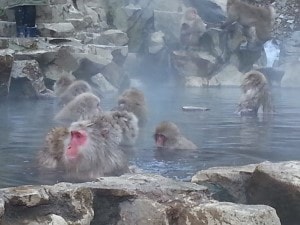 Snow monkeys near Nagano
Snow monkeys near Nagano 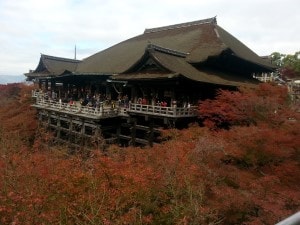 Kiyomizu-Dera
Kiyomizu-Dera 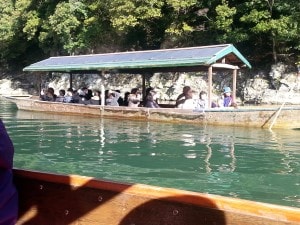 Boats at Arashiyama
Boats at Arashiyama 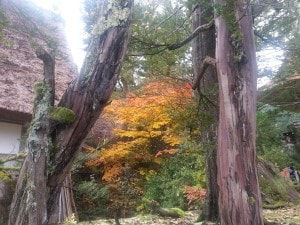 Shirakawa-go leaf viewing
Shirakawa-go leaf viewing 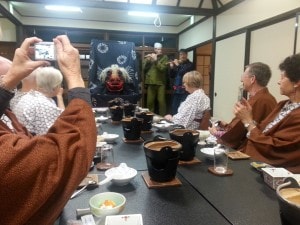 Ryokan Lion Dance
Ryokan Lion Dance 